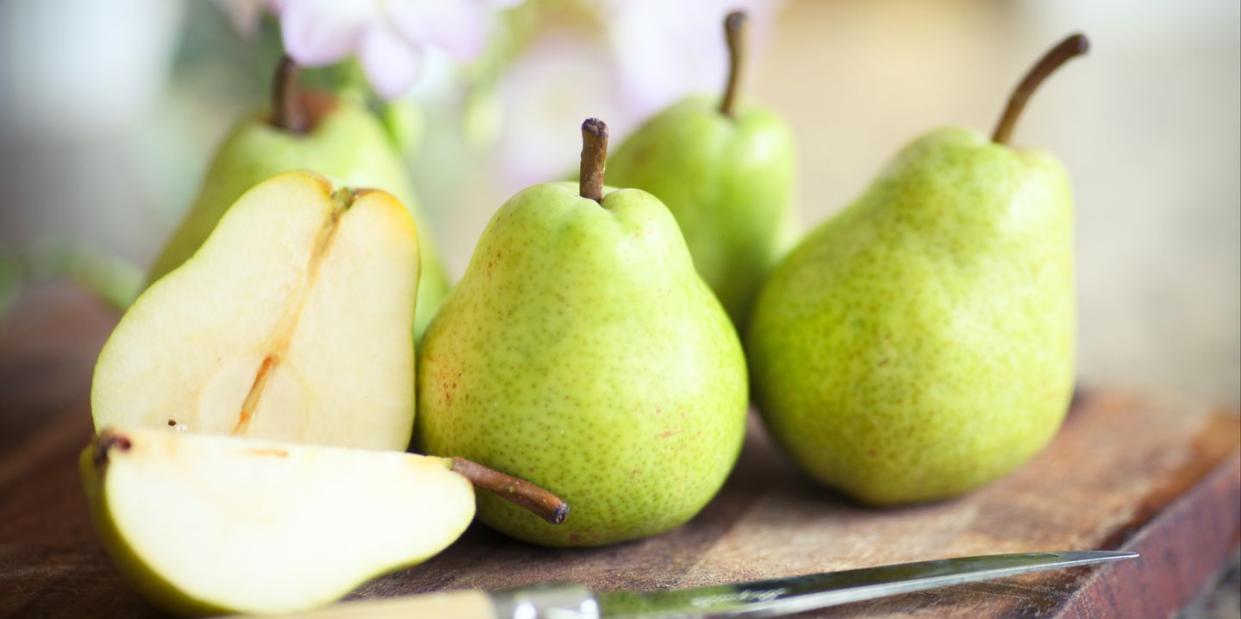The Best Way to Freeze Pears

Freezing pears sounds so easy: Just slice 'em, pop 'em in the freezer and reward yourself with Ree Drummond's Pear Clafouti any time of year, right? If only that were the case! Find out how to freeze pears the right way—otherwise your ripe pears will turn to brown mush!
Pears have a relatively short growing season that begins in August and ends in October. You can usually get pears year-round, but like apples, pears are best when they're at their peak. They're super versatile: Pair them with cheese, like for these Pear and Blue Cheese Crostini, turn them into amazing desserts, like Ree's Pear Crisp, or simply eat them out of hand!
If you want to freeze pears simply for smoothies or sauces, go ahead and just cut up the pears and freeze them. But for any frozen goals beyond that, whether you're making an upside-down cake or adding pears to a fruit salad, you need to know how to freeze pears so they don't brown and soften when thawed—read on for instructions, plus some helpful tips and tricks.
What kind of pear is best for freezing?
Any variety of pear can be frozen, but stick with pears that are ripe. Test for ripeness by pressing gently near the top of the "neck." If it gives, it’s ready for freezing—or eating!
Should you peel pears before freezing?
It's up to you. Just keep in mind that the amount of fiber in a pear doubles when you leave the peel on—the peel houses most of the fruit’s beneficial nutrients and antioxidants. If you're making a smoothie or puree, you can freeze pears with the peel on—it won’t detract from the texture or appearance. But for some baking recipes, you may want to peel the pears first.
Should you slice pears before freezing?
Think about how you’ll use the pears: Halved for poaching? Chopped for muffins? Or maybe sliced for a pie? It's smart to plan ahead before you freeze your pears, especially if you plan to add them to a recipe straight from the freezer. You don't want to freeze whole pears, so you'll need to slice them in some way—it just depends on your end game. Remember to factor in logistics like freezer space, too—though halved pears are great for poaching, they’re bulky to store, whereas sliced pears make the most of any storage space, particularly if you stack them flat in freezer bags.
What’s the best way to freeze pears?
There are two methods you can try:
Salt-Water Method: This involves putting sliced pears in a bowl of salt water before freezing. The salt water eliminates the need for a discoloration agent (like lemon juice or a citric acid compound like Fruit Fresh), and the pears maintain their structural integrity during freezing and thawing. To start, fill a large bowl with ice water, then sprinkle in enough table salt to cover the bottom of the bowl. Peel and prep the pears, dropping them into the salt water as you go. Once finished, drain the pears and rinse thoroughly under cool water. (You won’t taste the salt!) Arrange in an even layer on lined baking sheets, leaving enough room for cold air to circulate, then freeze until firm; transfer the frozen pears to freezer bags for longer storage. This method is best if you're using your pears for baking and cooking.
Syrup-Packed Method: Though not as convenient as a simple sodium rinse, packing pears in syrup preserves the pear, leaving you with an end product that can be used uncooked—perfect for salads or as a garnish. To pack pears in syrup, first prepare a syrup of sugar and water in a saucepan and heat until the sugar dissolves (use 2 to 4 cups sugar for every 4 cups water). Bring the syrup to a simmer, add the pears and cook for about 2 minutes, then let cool. Pack the fruit in freezer-safe bags or containers, using about ½ cup cooled syrup for each pint of fruit. Pack flat in bags to coat the fruit in syrup. If using containers, leave room for headspace, and use a piece of crumbled parchment or wax paper to keep the pears submerged.

